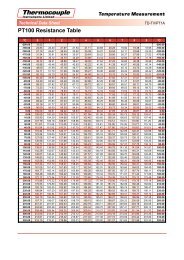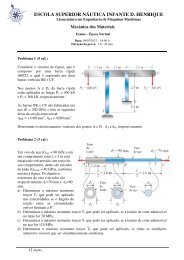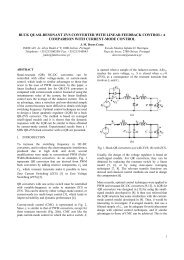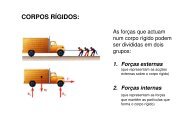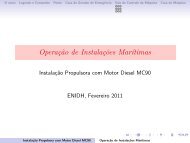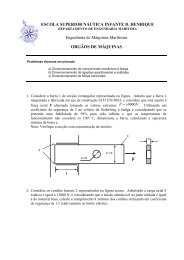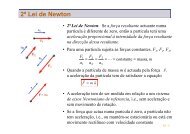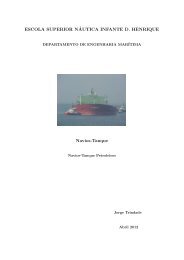Textos de Apoio (pdf)
Textos de Apoio (pdf)
Textos de Apoio (pdf)
Create successful ePaper yourself
Turn your PDF publications into a flip-book with our unique Google optimized e-Paper software.
which the propeller <strong>de</strong>livers to the water<br />
P T<br />
= T × V A<br />
, i.e.:<br />
P R × V<br />
E T RT<br />
/ T 1−<br />
t<br />
H<br />
= = = =<br />
P T × V V V<br />
T<br />
A A<br />
/<br />
1−<br />
w<br />
Propeller<br />
efficiency<br />
0.7<br />
o<br />
Large tankers<br />
>150,000 DWT<br />
Small tankers<br />
20,000 DWT<br />
Reefers<br />
Container ships<br />
For a ship with one propeller, the hull<br />
efficiency η H<br />
is usually in the range of<br />
1.1 to 1.4, with the high value for ships<br />
with high block coefficients. For ships<br />
with two propellers and a conventional<br />
aftbody form of the hull, the hull efficiency<br />
η H<br />
is approx. 0.95 to 1.05, again<br />
with the high value for a high block coefficient.<br />
However, for a twin-skeg ship<br />
with two propellers, the hull coefficient<br />
η H<br />
will be almost unchanged compared<br />
with the single-propeller case.<br />
0.6<br />
0.5<br />
0.4<br />
0.3<br />
n ( revs./s )<br />
1.66<br />
2.00<br />
Open water propeller efficiency η O<br />
Propeller efficiency η O<br />
is related to<br />
working in open water, i.e. the propeller<br />
works in a homogeneous wake field<br />
with no hull in front of it.<br />
0.2<br />
0.1<br />
The propeller efficiency <strong>de</strong>pends, especially,<br />
on the speed of advance V A<br />
,<br />
thrust force T, rate of revolution n, diameter<br />
d and, moreover, i.a. on the <strong>de</strong>sign<br />
of the propeller, i.e. the number of<br />
bla<strong>de</strong>s, disk area ratio, and pitch/diameter<br />
ratio – which will be discussed<br />
later in this chapter. The propeller efficiency<br />
η O<br />
can vary between approx.<br />
0.35 and 0.75, with the high value being<br />
valid for propellers with a high<br />
speed of advance V A<br />
, Ref. [3].<br />
Fig. 8 shows the obtainable propeller<br />
efficiency η O<br />
shown as a function of the<br />
speed of advance V A<br />
, which is given in<br />
dimensionless form as:<br />
J =<br />
VA<br />
n×<br />
d<br />
where J is the advance number of the<br />
propeller.<br />
Relative rotative efficiency η R<br />
The actual velocity of the water flowing<br />
to the propeller behind the hull is neither<br />
constant nor at right angles to the<br />
propeller’s disk area, but has a kind of<br />
rotational flow. Therefore, compared<br />
with when the propeller is working in<br />
open water, the propeller’s efficiency is<br />
0<br />
0 0.1<br />
0.2 0.3<br />
affected by the η R<br />
factor – called the<br />
propeller’s relative rotative efficiency.<br />
On ships with a single propeller the<br />
rotative efficiency η R<br />
is, normally, around<br />
1.0 to 1.07, in other words, the rotation<br />
of the water has a beneficial effect. The<br />
rotative efficiency η R<br />
on a ship with a<br />
conventional hull shape and with two<br />
propellers will normally be less, approx.<br />
0.98, whereas for a twin-skeg ship with<br />
two propellers, the rotative efficiency η R<br />
will be almost unchanged.<br />
In combination with w and t, η R<br />
is probably<br />
often being used to adjust the results<br />
of mo<strong>de</strong>l tank tests to the theory.<br />
0.4 0.5 0.6 0.7<br />
Advance number J =<br />
Fig. 8: Obtainable propeller efficiency – open water, Ref. [3], page 213<br />
Propeller efficiency η B<br />
working behind<br />
the ship<br />
The ratio between the thrust power P T<br />
,<br />
which the propeller <strong>de</strong>livers to the water,<br />
and the power P D<br />
, which is <strong>de</strong>livered<br />
to the propeller, i.e. the propeller<br />
efficiency η B<br />
for a propeller working<br />
behind the ship, is <strong>de</strong>fined as:<br />
PT<br />
<br />
B<br />
= =<br />
o<br />
×<br />
P<br />
D<br />
Propulsive efficiency η D<br />
The propulsive efficiency η D<br />
, which<br />
must not be confused with the open<br />
water propeller efficiency η O<br />
, is equal to<br />
the ratio between the effective (towing)<br />
power P E<br />
and the necessary power<br />
<strong>de</strong>livered to the propeller P D<br />
, i.e.:<br />
<br />
D<br />
P<br />
P<br />
E E<br />
= = ×<br />
PD<br />
PT<br />
PT<br />
P<br />
= η H<br />
× η B<br />
= η H<br />
× η O<br />
× η R<br />
D<br />
VA<br />
n x d<br />
R<br />
12


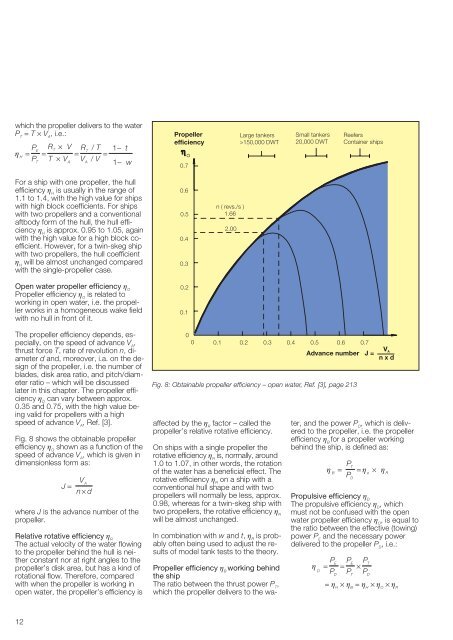
![Conceitos transmissao de dados .Sinais[.pdf]](https://img.yumpu.com/50982145/1/190x146/conceitos-transmissao-de-dados-sinaispdf.jpg?quality=85)
![Packages e interfaces[.pdf]](https://img.yumpu.com/50629553/1/190x134/packages-e-interfacespdf.jpg?quality=85)
